Entrepreneurship: Types, Impacts, and Business Analysis Report
VerifiedAdded on 2022/03/22
|25
|5808
|25
Report
AI Summary
This report provides a comprehensive overview of entrepreneurship, exploring different types of ventures, including small businesses, scalable startups, large corporations, and social enterprises. It defines entrepreneurship and examines the similarities and differences among these ventures, focusing on their objectives, investors, and size. The report delves into the characteristics of successful entrepreneurs, their personality traits, motivations, and the impact of family background and education. Furthermore, it analyzes the economic impact of small and medium-sized enterprises (SMEs) in the UK and South Korea, using statistical data to illustrate their size, distribution, and contribution to various sectors. The analysis includes median profit figures and a breakdown by sector, providing valuable insights into the role of SMEs and new ventures in the social economy. The report also highlights the contributions of different businesses to various economic aspects and the role of SMEs and new ventures in the social economy.

1
Developing Entrepreneurial Skills
Developing Entrepreneurial Skills
Paraphrase This Document
Need a fresh take? Get an instant paraphrase of this document with our AI Paraphraser
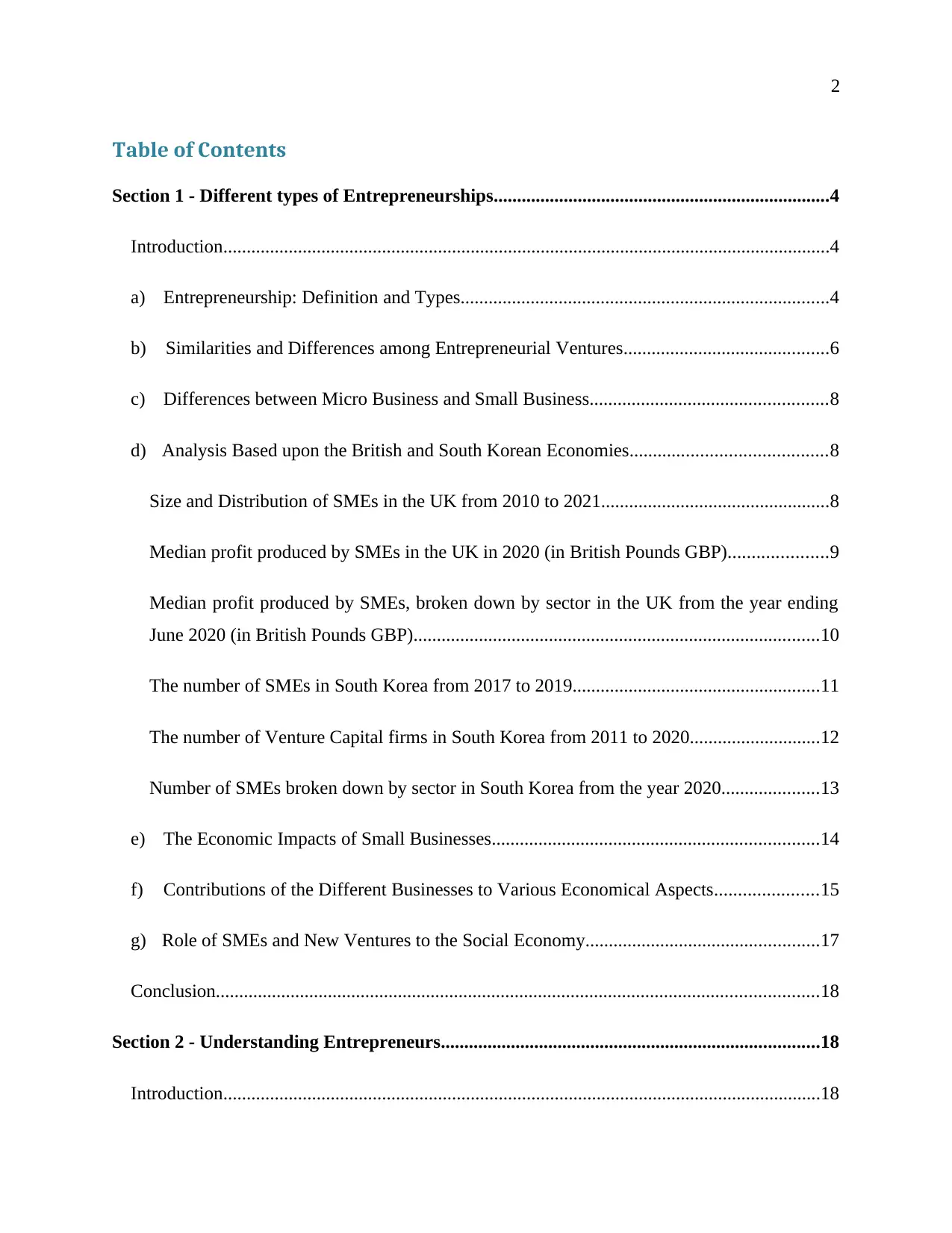
2
Table of Contents
Section 1 - Different types of Entrepreneurships........................................................................4
Introduction..................................................................................................................................4
a) Entrepreneurship: Definition and Types...............................................................................4
b) Similarities and Differences among Entrepreneurial Ventures............................................6
c) Differences between Micro Business and Small Business...................................................8
d) Analysis Based upon the British and South Korean Economies..........................................8
Size and Distribution of SMEs in the UK from 2010 to 2021.................................................8
Median profit produced by SMEs in the UK in 2020 (in British Pounds GBP).....................9
Median profit produced by SMEs, broken down by sector in the UK from the year ending
June 2020 (in British Pounds GBP).......................................................................................10
The number of SMEs in South Korea from 2017 to 2019.....................................................11
The number of Venture Capital firms in South Korea from 2011 to 2020............................12
Number of SMEs broken down by sector in South Korea from the year 2020.....................13
e) The Economic Impacts of Small Businesses......................................................................14
f) Contributions of the Different Businesses to Various Economical Aspects......................15
g) Role of SMEs and New Ventures to the Social Economy..................................................17
Conclusion.................................................................................................................................18
Section 2 - Understanding Entrepreneurs.................................................................................18
Introduction................................................................................................................................18
Table of Contents
Section 1 - Different types of Entrepreneurships........................................................................4
Introduction..................................................................................................................................4
a) Entrepreneurship: Definition and Types...............................................................................4
b) Similarities and Differences among Entrepreneurial Ventures............................................6
c) Differences between Micro Business and Small Business...................................................8
d) Analysis Based upon the British and South Korean Economies..........................................8
Size and Distribution of SMEs in the UK from 2010 to 2021.................................................8
Median profit produced by SMEs in the UK in 2020 (in British Pounds GBP).....................9
Median profit produced by SMEs, broken down by sector in the UK from the year ending
June 2020 (in British Pounds GBP).......................................................................................10
The number of SMEs in South Korea from 2017 to 2019.....................................................11
The number of Venture Capital firms in South Korea from 2011 to 2020............................12
Number of SMEs broken down by sector in South Korea from the year 2020.....................13
e) The Economic Impacts of Small Businesses......................................................................14
f) Contributions of the Different Businesses to Various Economical Aspects......................15
g) Role of SMEs and New Ventures to the Social Economy..................................................17
Conclusion.................................................................................................................................18
Section 2 - Understanding Entrepreneurs.................................................................................18
Introduction................................................................................................................................18

3
a) Successful Entrepreneurs....................................................................................................19
b) Personality, Motivations, and Mindset of a Successful Entrepreneur................................20
c) The Impact of Family Background & Entrepreneurship Education on Foster the
Successful Entrepreneurship .....................................................................................................20
Conclusion.................................................................................................................................20
References.................................................................................................................................22
a) Successful Entrepreneurs....................................................................................................19
b) Personality, Motivations, and Mindset of a Successful Entrepreneur................................20
c) The Impact of Family Background & Entrepreneurship Education on Foster the
Successful Entrepreneurship .....................................................................................................20
Conclusion.................................................................................................................................20
References.................................................................................................................................22
⊘ This is a preview!⊘
Do you want full access?
Subscribe today to unlock all pages.

Trusted by 1+ million students worldwide
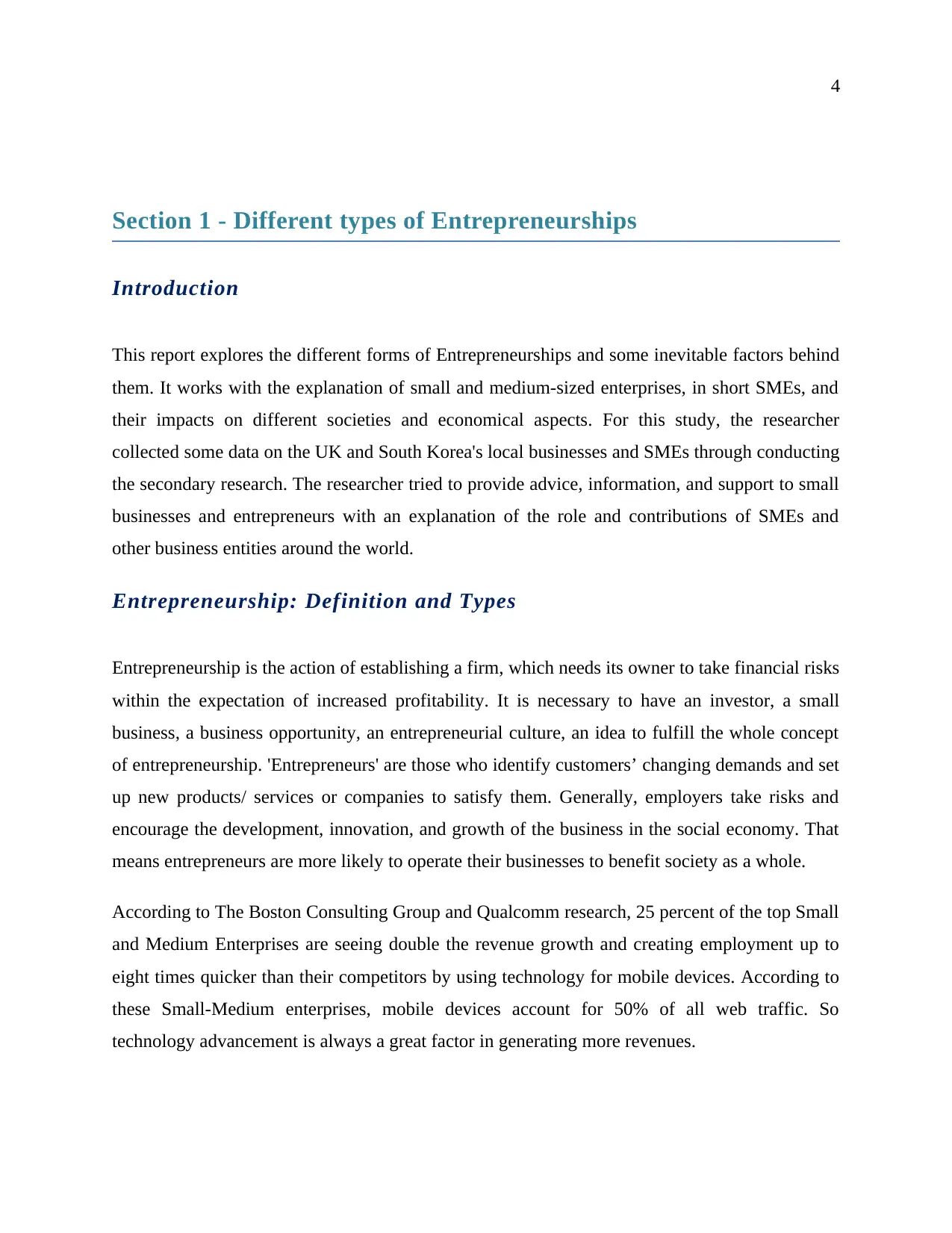
4
Section 1 - Different types of Entrepreneurships
Introduction
This report explores the different forms of Entrepreneurships and some inevitable factors behind
them. It works with the explanation of small and medium-sized enterprises, in short SMEs, and
their impacts on different societies and economical aspects. For this study, the researcher
collected some data on the UK and South Korea's local businesses and SMEs through conducting
the secondary research. The researcher tried to provide advice, information, and support to small
businesses and entrepreneurs with an explanation of the role and contributions of SMEs and
other business entities around the world.
Entrepreneurship: Definition and Types
Entrepreneurship is the action of establishing a firm, which needs its owner to take financial risks
within the expectation of increased profitability. It is necessary to have an investor, a small
business, a business opportunity, an entrepreneurial culture, an idea to fulfill the whole concept
of entrepreneurship. 'Entrepreneurs' are those who identify customers’ changing demands and set
up new products/ services or companies to satisfy them. Generally, employers take risks and
encourage the development, innovation, and growth of the business in the social economy. That
means entrepreneurs are more likely to operate their businesses to benefit society as a whole.
According to The Boston Consulting Group and Qualcomm research, 25 percent of the top Small
and Medium Enterprises are seeing double the revenue growth and creating employment up to
eight times quicker than their competitors by using technology for mobile devices. According to
these Small-Medium enterprises, mobile devices account for 50% of all web traffic. So
technology advancement is always a great factor in generating more revenues.
Section 1 - Different types of Entrepreneurships
Introduction
This report explores the different forms of Entrepreneurships and some inevitable factors behind
them. It works with the explanation of small and medium-sized enterprises, in short SMEs, and
their impacts on different societies and economical aspects. For this study, the researcher
collected some data on the UK and South Korea's local businesses and SMEs through conducting
the secondary research. The researcher tried to provide advice, information, and support to small
businesses and entrepreneurs with an explanation of the role and contributions of SMEs and
other business entities around the world.
Entrepreneurship: Definition and Types
Entrepreneurship is the action of establishing a firm, which needs its owner to take financial risks
within the expectation of increased profitability. It is necessary to have an investor, a small
business, a business opportunity, an entrepreneurial culture, an idea to fulfill the whole concept
of entrepreneurship. 'Entrepreneurs' are those who identify customers’ changing demands and set
up new products/ services or companies to satisfy them. Generally, employers take risks and
encourage the development, innovation, and growth of the business in the social economy. That
means entrepreneurs are more likely to operate their businesses to benefit society as a whole.
According to The Boston Consulting Group and Qualcomm research, 25 percent of the top Small
and Medium Enterprises are seeing double the revenue growth and creating employment up to
eight times quicker than their competitors by using technology for mobile devices. According to
these Small-Medium enterprises, mobile devices account for 50% of all web traffic. So
technology advancement is always a great factor in generating more revenues.
Paraphrase This Document
Need a fresh take? Get an instant paraphrase of this document with our AI Paraphraser
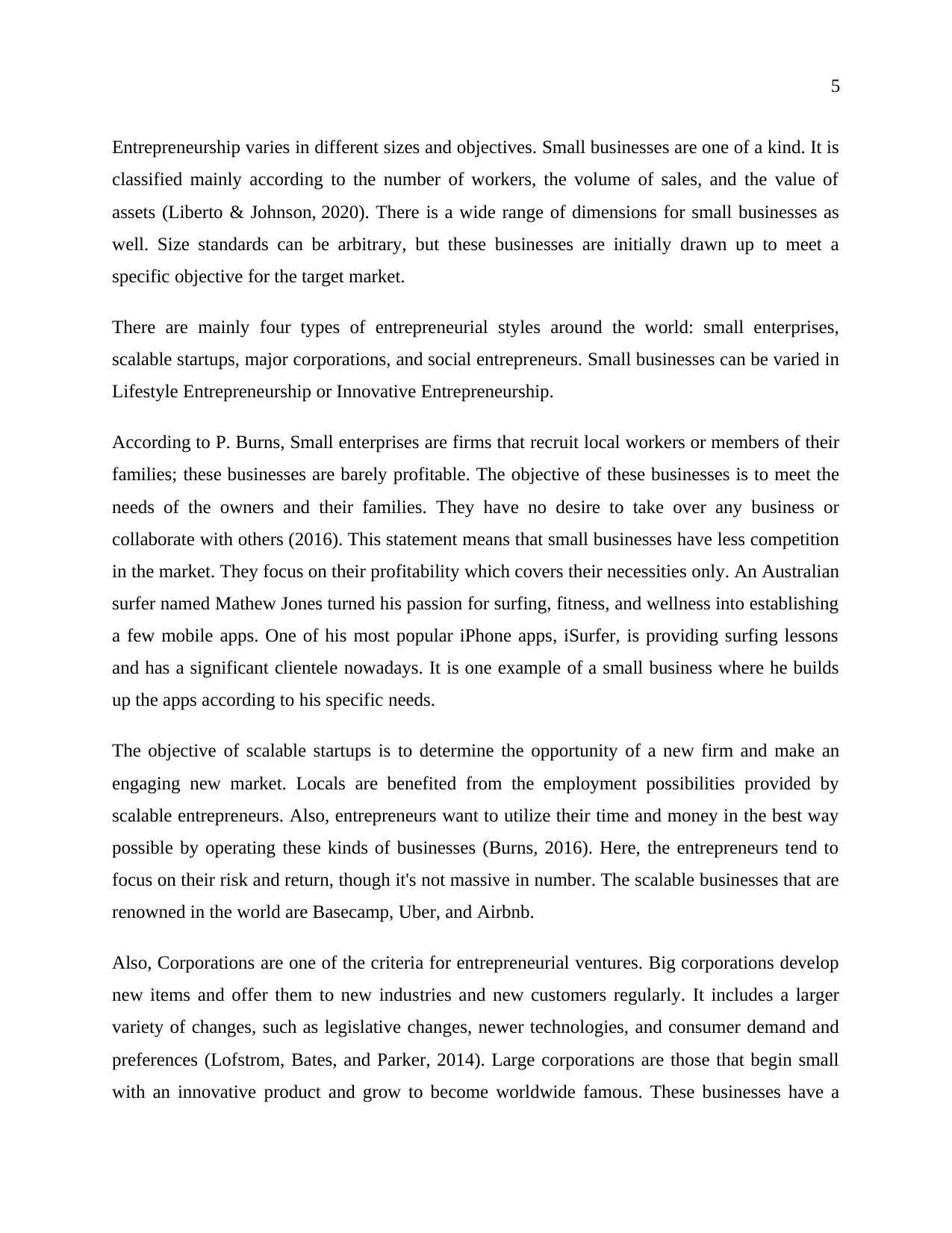
5
Entrepreneurship varies in different sizes and objectives. Small businesses are one of a kind. It is
classified mainly according to the number of workers, the volume of sales, and the value of
assets (Liberto & Johnson, 2020). There is a wide range of dimensions for small businesses as
well. Size standards can be arbitrary, but these businesses are initially drawn up to meet a
specific objective for the target market.
There are mainly four types of entrepreneurial styles around the world: small enterprises,
scalable startups, major corporations, and social entrepreneurs. Small businesses can be varied in
Lifestyle Entrepreneurship or Innovative Entrepreneurship.
According to P. Burns, Small enterprises are firms that recruit local workers or members of their
families; these businesses are barely profitable. The objective of these businesses is to meet the
needs of the owners and their families. They have no desire to take over any business or
collaborate with others (2016). This statement means that small businesses have less competition
in the market. They focus on their profitability which covers their necessities only. An Australian
surfer named Mathew Jones turned his passion for surfing, fitness, and wellness into establishing
a few mobile apps. One of his most popular iPhone apps, iSurfer, is providing surfing lessons
and has a significant clientele nowadays. It is one example of a small business where he builds
up the apps according to his specific needs.
The objective of scalable startups is to determine the opportunity of a new firm and make an
engaging new market. Locals are benefited from the employment possibilities provided by
scalable entrepreneurs. Also, entrepreneurs want to utilize their time and money in the best way
possible by operating these kinds of businesses (Burns, 2016). Here, the entrepreneurs tend to
focus on their risk and return, though it's not massive in number. The scalable businesses that are
renowned in the world are Basecamp, Uber, and Airbnb.
Also, Corporations are one of the criteria for entrepreneurial ventures. Big corporations develop
new items and offer them to new industries and new customers regularly. It includes a larger
variety of changes, such as legislative changes, newer technologies, and consumer demand and
preferences (Lofstrom, Bates, and Parker, 2014). Large corporations are those that begin small
with an innovative product and grow to become worldwide famous. These businesses have a
Entrepreneurship varies in different sizes and objectives. Small businesses are one of a kind. It is
classified mainly according to the number of workers, the volume of sales, and the value of
assets (Liberto & Johnson, 2020). There is a wide range of dimensions for small businesses as
well. Size standards can be arbitrary, but these businesses are initially drawn up to meet a
specific objective for the target market.
There are mainly four types of entrepreneurial styles around the world: small enterprises,
scalable startups, major corporations, and social entrepreneurs. Small businesses can be varied in
Lifestyle Entrepreneurship or Innovative Entrepreneurship.
According to P. Burns, Small enterprises are firms that recruit local workers or members of their
families; these businesses are barely profitable. The objective of these businesses is to meet the
needs of the owners and their families. They have no desire to take over any business or
collaborate with others (2016). This statement means that small businesses have less competition
in the market. They focus on their profitability which covers their necessities only. An Australian
surfer named Mathew Jones turned his passion for surfing, fitness, and wellness into establishing
a few mobile apps. One of his most popular iPhone apps, iSurfer, is providing surfing lessons
and has a significant clientele nowadays. It is one example of a small business where he builds
up the apps according to his specific needs.
The objective of scalable startups is to determine the opportunity of a new firm and make an
engaging new market. Locals are benefited from the employment possibilities provided by
scalable entrepreneurs. Also, entrepreneurs want to utilize their time and money in the best way
possible by operating these kinds of businesses (Burns, 2016). Here, the entrepreneurs tend to
focus on their risk and return, though it's not massive in number. The scalable businesses that are
renowned in the world are Basecamp, Uber, and Airbnb.
Also, Corporations are one of the criteria for entrepreneurial ventures. Big corporations develop
new items and offer them to new industries and new customers regularly. It includes a larger
variety of changes, such as legislative changes, newer technologies, and consumer demand and
preferences (Lofstrom, Bates, and Parker, 2014). Large corporations are those that begin small
with an innovative product and grow to become worldwide famous. These businesses have a
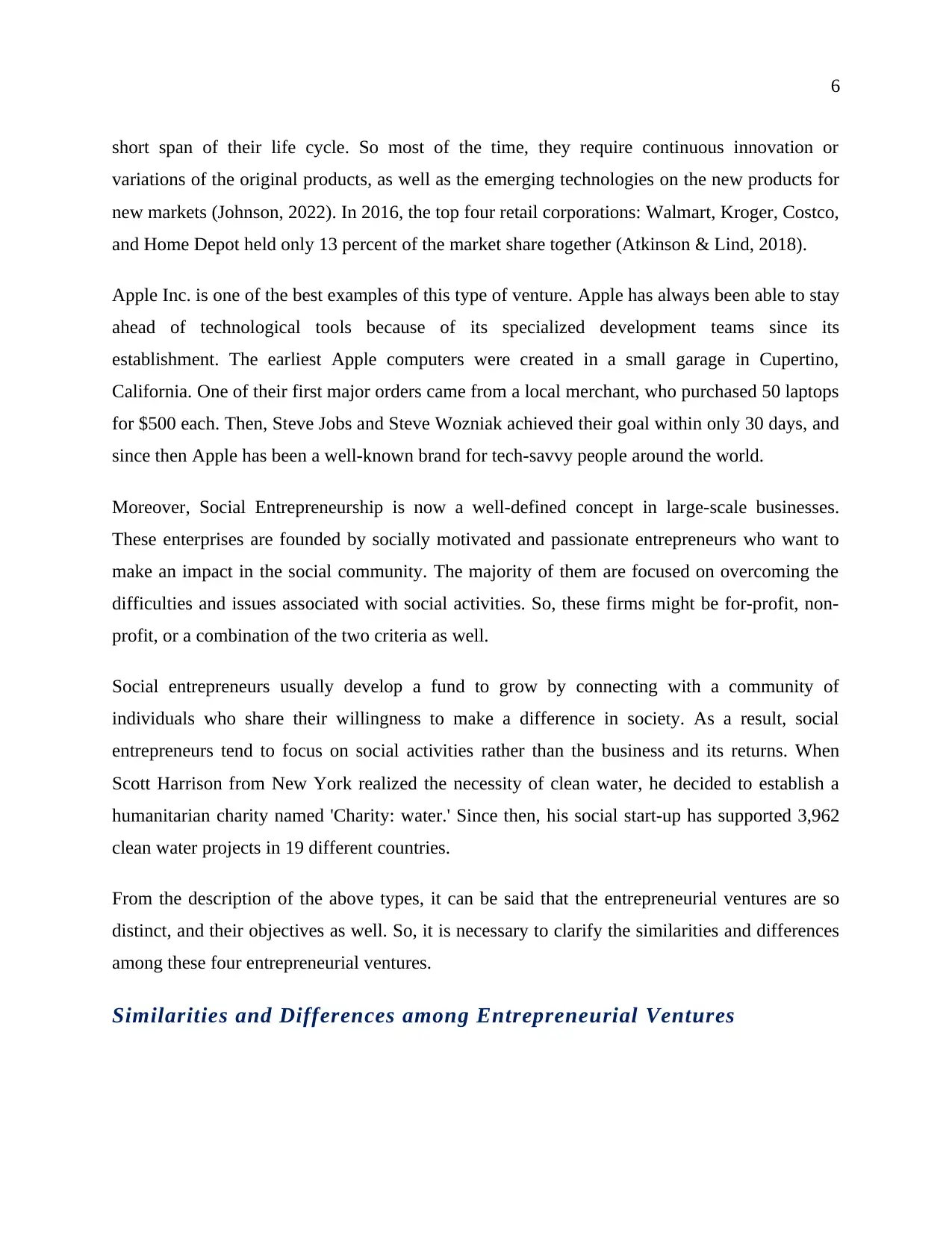
6
short span of their life cycle. So most of the time, they require continuous innovation or
variations of the original products, as well as the emerging technologies on the new products for
new markets (Johnson, 2022). In 2016, the top four retail corporations: Walmart, Kroger, Costco,
and Home Depot held only 13 percent of the market share together (Atkinson & Lind, 2018).
Apple Inc. is one of the best examples of this type of venture. Apple has always been able to stay
ahead of technological tools because of its specialized development teams since its
establishment. The earliest Apple computers were created in a small garage in Cupertino,
California. One of their first major orders came from a local merchant, who purchased 50 laptops
for $500 each. Then, Steve Jobs and Steve Wozniak achieved their goal within only 30 days, and
since then Apple has been a well-known brand for tech-savvy people around the world.
Moreover, Social Entrepreneurship is now a well-defined concept in large-scale businesses.
These enterprises are founded by socially motivated and passionate entrepreneurs who want to
make an impact in the social community. The majority of them are focused on overcoming the
difficulties and issues associated with social activities. So, these firms might be for-profit, non-
profit, or a combination of the two criteria as well.
Social entrepreneurs usually develop a fund to grow by connecting with a community of
individuals who share their willingness to make a difference in society. As a result, social
entrepreneurs tend to focus on social activities rather than the business and its returns. When
Scott Harrison from New York realized the necessity of clean water, he decided to establish a
humanitarian charity named 'Charity: water.' Since then, his social start-up has supported 3,962
clean water projects in 19 different countries.
From the description of the above types, it can be said that the entrepreneurial ventures are so
distinct, and their objectives as well. So, it is necessary to clarify the similarities and differences
among these four entrepreneurial ventures.
Similarities and Differences among Entrepreneurial Ventures
short span of their life cycle. So most of the time, they require continuous innovation or
variations of the original products, as well as the emerging technologies on the new products for
new markets (Johnson, 2022). In 2016, the top four retail corporations: Walmart, Kroger, Costco,
and Home Depot held only 13 percent of the market share together (Atkinson & Lind, 2018).
Apple Inc. is one of the best examples of this type of venture. Apple has always been able to stay
ahead of technological tools because of its specialized development teams since its
establishment. The earliest Apple computers were created in a small garage in Cupertino,
California. One of their first major orders came from a local merchant, who purchased 50 laptops
for $500 each. Then, Steve Jobs and Steve Wozniak achieved their goal within only 30 days, and
since then Apple has been a well-known brand for tech-savvy people around the world.
Moreover, Social Entrepreneurship is now a well-defined concept in large-scale businesses.
These enterprises are founded by socially motivated and passionate entrepreneurs who want to
make an impact in the social community. The majority of them are focused on overcoming the
difficulties and issues associated with social activities. So, these firms might be for-profit, non-
profit, or a combination of the two criteria as well.
Social entrepreneurs usually develop a fund to grow by connecting with a community of
individuals who share their willingness to make a difference in society. As a result, social
entrepreneurs tend to focus on social activities rather than the business and its returns. When
Scott Harrison from New York realized the necessity of clean water, he decided to establish a
humanitarian charity named 'Charity: water.' Since then, his social start-up has supported 3,962
clean water projects in 19 different countries.
From the description of the above types, it can be said that the entrepreneurial ventures are so
distinct, and their objectives as well. So, it is necessary to clarify the similarities and differences
among these four entrepreneurial ventures.
Similarities and Differences among Entrepreneurial Ventures
⊘ This is a preview!⊘
Do you want full access?
Subscribe today to unlock all pages.

Trusted by 1+ million students worldwide

7
Similarities Opportunities Target Risk/Return
Small
enterprises
Give family members
and friends opportunities
to progress in their
careers.
Attract customers with
a small investment.
Take small-scale risks
that require funding.
Scalable
startups
Increase employment
and career progression.
Continue operations in
the market.
Demand external capital
and risk to operate.
Large
corporations
Enhance business
employment and
competitiveness.
Require shareholders
based on their
ownership percentage.
Bringing competitors into
the market generates high
risks.
Social
entrepreneurs
Helpful for progressing
in one's career and
society.
Donations are required
and the efforts to bring
positive changes in
society.
Risks are connected to
society rather than
profitability.
Differences Size Objective Investors
Small
enterprises
Micro/small,
approximately 1 to 9
employees.
To gain
individual profit.
Self, family members,
and friends.
Scalable
startups
Small to medium,
approximately 10 to 49
employees, or 50 to 249
employees.
To survive in the
market and generate
growth.
Who provides SME
Financial Services; it can
be any financial
institution or non-banking
financial institution.
Large
corporations
Large,
250 employees or more.
To optimize the profit. The general public is
given shares in the
company to invest in it.
Social
entrepreneurs
Medium to large,
approximately
50 to 250 employees or
more.
To serve the
community.
Local and foreign donors.
Similarities Opportunities Target Risk/Return
Small
enterprises
Give family members
and friends opportunities
to progress in their
careers.
Attract customers with
a small investment.
Take small-scale risks
that require funding.
Scalable
startups
Increase employment
and career progression.
Continue operations in
the market.
Demand external capital
and risk to operate.
Large
corporations
Enhance business
employment and
competitiveness.
Require shareholders
based on their
ownership percentage.
Bringing competitors into
the market generates high
risks.
Social
entrepreneurs
Helpful for progressing
in one's career and
society.
Donations are required
and the efforts to bring
positive changes in
society.
Risks are connected to
society rather than
profitability.
Differences Size Objective Investors
Small
enterprises
Micro/small,
approximately 1 to 9
employees.
To gain
individual profit.
Self, family members,
and friends.
Scalable
startups
Small to medium,
approximately 10 to 49
employees, or 50 to 249
employees.
To survive in the
market and generate
growth.
Who provides SME
Financial Services; it can
be any financial
institution or non-banking
financial institution.
Large
corporations
Large,
250 employees or more.
To optimize the profit. The general public is
given shares in the
company to invest in it.
Social
entrepreneurs
Medium to large,
approximately
50 to 250 employees or
more.
To serve the
community.
Local and foreign donors.
Paraphrase This Document
Need a fresh take? Get an instant paraphrase of this document with our AI Paraphraser
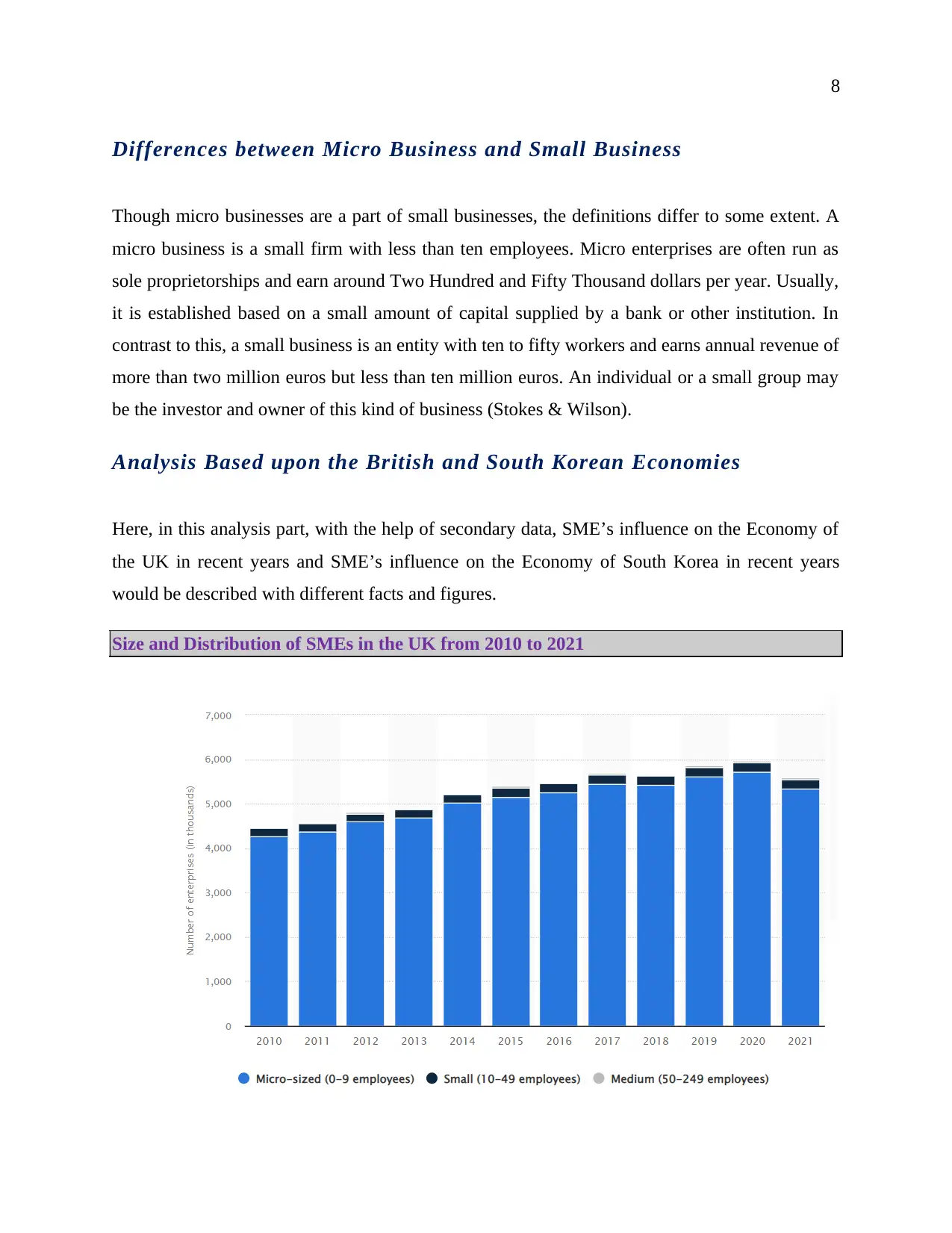
8
Differences between Micro Business and Small Business
Though micro businesses are a part of small businesses, the definitions differ to some extent. A
micro business is a small firm with less than ten employees. Micro enterprises are often run as
sole proprietorships and earn around Two Hundred and Fifty Thousand dollars per year. Usually,
it is established based on a small amount of capital supplied by a bank or other institution. In
contrast to this, a small business is an entity with ten to fifty workers and earns annual revenue of
more than two million euros but less than ten million euros. An individual or a small group may
be the investor and owner of this kind of business (Stokes & Wilson).
Analysis Based upon the British and South Korean Economies
Here, in this analysis part, with the help of secondary data, SME’s influence on the Economy of
the UK in recent years and SME’s influence on the Economy of South Korea in recent years
would be described with different facts and figures.
Size and Distribution of SMEs in the UK from 2010 to 2021
Differences between Micro Business and Small Business
Though micro businesses are a part of small businesses, the definitions differ to some extent. A
micro business is a small firm with less than ten employees. Micro enterprises are often run as
sole proprietorships and earn around Two Hundred and Fifty Thousand dollars per year. Usually,
it is established based on a small amount of capital supplied by a bank or other institution. In
contrast to this, a small business is an entity with ten to fifty workers and earns annual revenue of
more than two million euros but less than ten million euros. An individual or a small group may
be the investor and owner of this kind of business (Stokes & Wilson).
Analysis Based upon the British and South Korean Economies
Here, in this analysis part, with the help of secondary data, SME’s influence on the Economy of
the UK in recent years and SME’s influence on the Economy of South Korea in recent years
would be described with different facts and figures.
Size and Distribution of SMEs in the UK from 2010 to 2021
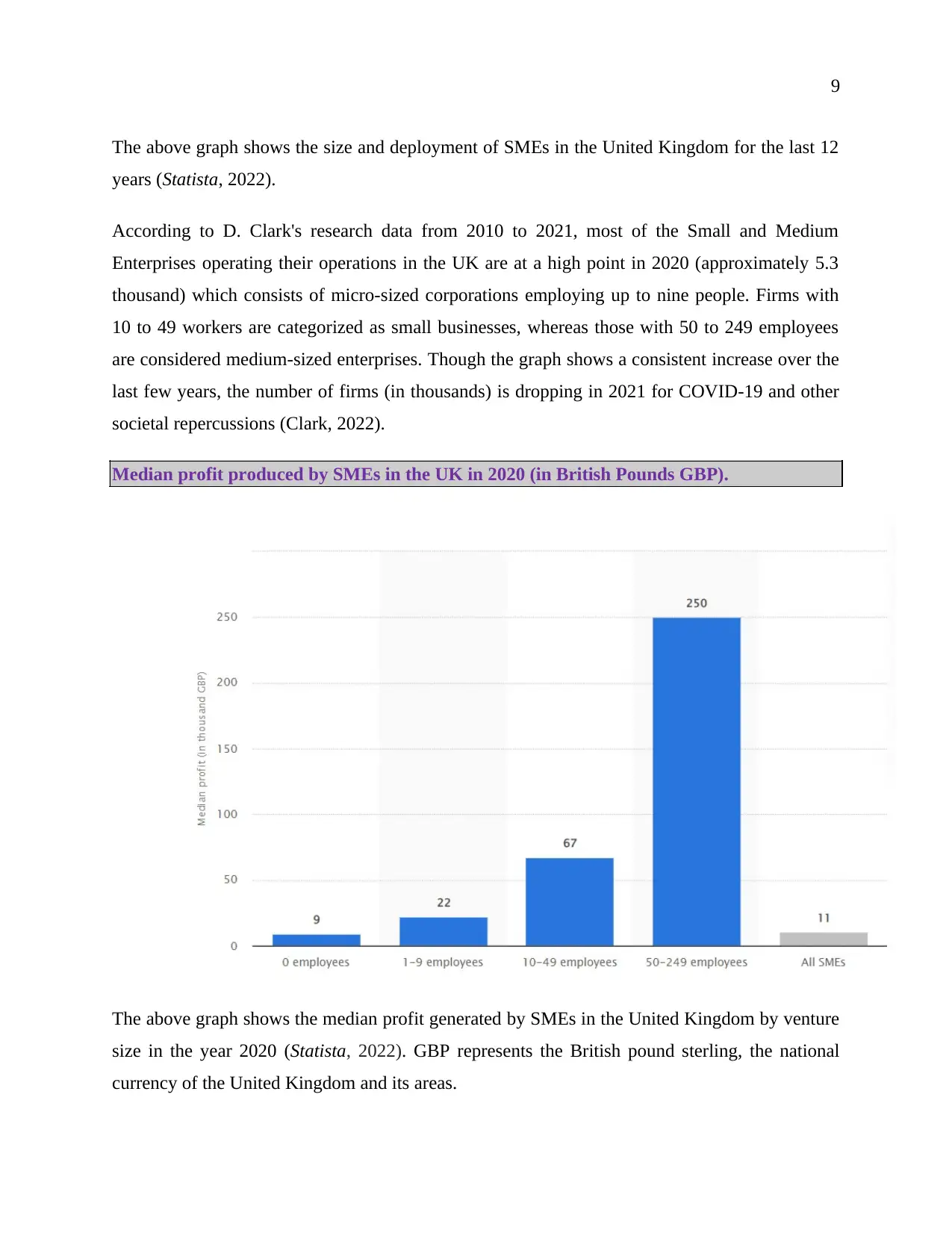
9
The above graph shows the size and deployment of SMEs in the United Kingdom for the last 12
years (Statista, 2022).
According to D. Clark's research data from 2010 to 2021, most of the Small and Medium
Enterprises operating their operations in the UK are at a high point in 2020 (approximately 5.3
thousand) which consists of micro-sized corporations employing up to nine people. Firms with
10 to 49 workers are categorized as small businesses, whereas those with 50 to 249 employees
are considered medium-sized enterprises. Though the graph shows a consistent increase over the
last few years, the number of firms (in thousands) is dropping in 2021 for COVID-19 and other
societal repercussions (Clark, 2022).
Median profit produced by SMEs in the UK in 2020 (in British Pounds GBP).
The above graph shows the median profit generated by SMEs in the United Kingdom by venture
size in the year 2020 (Statista, 2022). GBP represents the British pound sterling, the national
currency of the United Kingdom and its areas.
The above graph shows the size and deployment of SMEs in the United Kingdom for the last 12
years (Statista, 2022).
According to D. Clark's research data from 2010 to 2021, most of the Small and Medium
Enterprises operating their operations in the UK are at a high point in 2020 (approximately 5.3
thousand) which consists of micro-sized corporations employing up to nine people. Firms with
10 to 49 workers are categorized as small businesses, whereas those with 50 to 249 employees
are considered medium-sized enterprises. Though the graph shows a consistent increase over the
last few years, the number of firms (in thousands) is dropping in 2021 for COVID-19 and other
societal repercussions (Clark, 2022).
Median profit produced by SMEs in the UK in 2020 (in British Pounds GBP).
The above graph shows the median profit generated by SMEs in the United Kingdom by venture
size in the year 2020 (Statista, 2022). GBP represents the British pound sterling, the national
currency of the United Kingdom and its areas.
⊘ This is a preview!⊘
Do you want full access?
Subscribe today to unlock all pages.

Trusted by 1+ million students worldwide

10
The researcher D. Clark’s analyzed graph shows that small firms (mainly scalable startups with
50 to 249 people) benefitted more in thousands of GBP in the UK. The Median profit for them is
250 in thousand GBP, which means half of the enterprises are earning more than that amount,
and the other half are earning less of that amount (Clark, 2022).
Median profit produced by SMEs, broken down by sector in the UK from the year ending
June 2020 (in British Pounds GBP).
The above graph shows that the median profit generated by SMEs in the UK was broken down
by sector from the year's closing in June of 2020 (Statista, 2022).
According to D. Clark, it can be said from the graphical data that before June 2020, the most
profitable sector for SMEs in the UK was manufacturing, with a net value of 20,000 British
The researcher D. Clark’s analyzed graph shows that small firms (mainly scalable startups with
50 to 249 people) benefitted more in thousands of GBP in the UK. The Median profit for them is
250 in thousand GBP, which means half of the enterprises are earning more than that amount,
and the other half are earning less of that amount (Clark, 2022).
Median profit produced by SMEs, broken down by sector in the UK from the year ending
June 2020 (in British Pounds GBP).
The above graph shows that the median profit generated by SMEs in the UK was broken down
by sector from the year's closing in June of 2020 (Statista, 2022).
According to D. Clark, it can be said from the graphical data that before June 2020, the most
profitable sector for SMEs in the UK was manufacturing, with a net value of 20,000 British
Paraphrase This Document
Need a fresh take? Get an instant paraphrase of this document with our AI Paraphraser

11
pounds. Furthermore, the wholesale retail industry (Repair) had the most net value or cash flow
of 13,000 British pounds (Clark, 2022).
At the beginning of 2021, it was estimated that there were 5.5 million small enterprises, which
was contributing to 99.2 percent of all enterprises in the UK. One reason for this is the increase
in loans and start-up subsidies. Increased government financing, in the form of loans to state-
owned enterprises, makes a positive contribution to these businesses in the UK. While the entire
business population declined by 390,000 between 2020 and 2021, according to the latest data
from the Estimates of the Business Population for the UK and Regions in 2021, small and
medium-sized firms (SMEs) employ more than 99% of the UK's business workforce (UK Small
Business Statistics, 2021). SMEs generated £2.3 trillion in revenue, while big corporations
generated £1.6 trillion in the UK (Essential Facts You Should Know about SMEs in the UK,
2021).
The number of SMEs in South Korea from 2017 to 2019
pounds. Furthermore, the wholesale retail industry (Repair) had the most net value or cash flow
of 13,000 British pounds (Clark, 2022).
At the beginning of 2021, it was estimated that there were 5.5 million small enterprises, which
was contributing to 99.2 percent of all enterprises in the UK. One reason for this is the increase
in loans and start-up subsidies. Increased government financing, in the form of loans to state-
owned enterprises, makes a positive contribution to these businesses in the UK. While the entire
business population declined by 390,000 between 2020 and 2021, according to the latest data
from the Estimates of the Business Population for the UK and Regions in 2021, small and
medium-sized firms (SMEs) employ more than 99% of the UK's business workforce (UK Small
Business Statistics, 2021). SMEs generated £2.3 trillion in revenue, while big corporations
generated £1.6 trillion in the UK (Essential Facts You Should Know about SMEs in the UK,
2021).
The number of SMEs in South Korea from 2017 to 2019
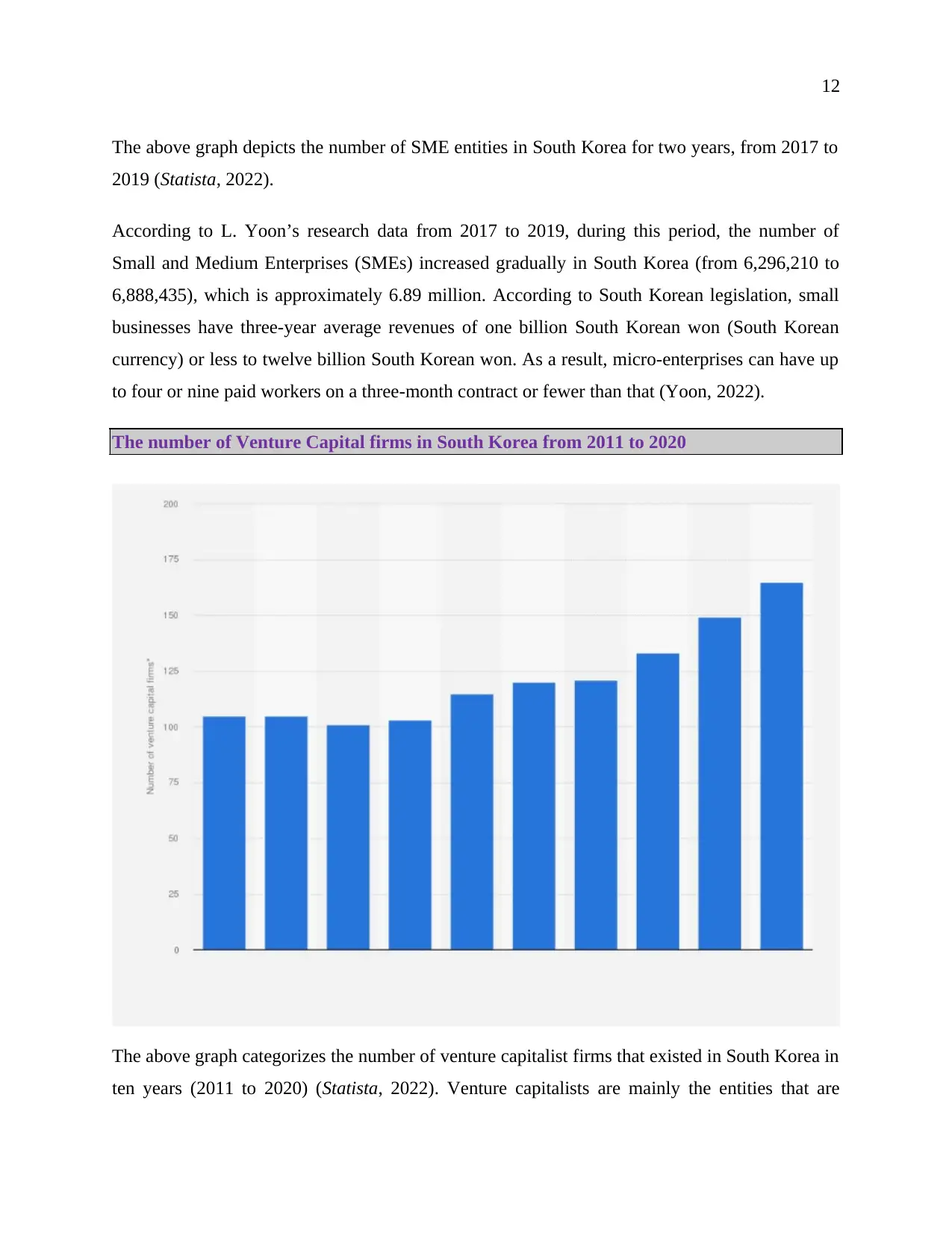
12
The above graph depicts the number of SME entities in South Korea for two years, from 2017 to
2019 (Statista, 2022).
According to L. Yoon’s research data from 2017 to 2019, during this period, the number of
Small and Medium Enterprises (SMEs) increased gradually in South Korea (from 6,296,210 to
6,888,435), which is approximately 6.89 million. According to South Korean legislation, small
businesses have three-year average revenues of one billion South Korean won (South Korean
currency) or less to twelve billion South Korean won. As a result, micro-enterprises can have up
to four or nine paid workers on a three-month contract or fewer than that (Yoon, 2022).
The number of Venture Capital firms in South Korea from 2011 to 2020
The above graph categorizes the number of venture capitalist firms that existed in South Korea in
ten years (2011 to 2020) (Statista, 2022). Venture capitalists are mainly the entities that are
The above graph depicts the number of SME entities in South Korea for two years, from 2017 to
2019 (Statista, 2022).
According to L. Yoon’s research data from 2017 to 2019, during this period, the number of
Small and Medium Enterprises (SMEs) increased gradually in South Korea (from 6,296,210 to
6,888,435), which is approximately 6.89 million. According to South Korean legislation, small
businesses have three-year average revenues of one billion South Korean won (South Korean
currency) or less to twelve billion South Korean won. As a result, micro-enterprises can have up
to four or nine paid workers on a three-month contract or fewer than that (Yoon, 2022).
The number of Venture Capital firms in South Korea from 2011 to 2020
The above graph categorizes the number of venture capitalist firms that existed in South Korea in
ten years (2011 to 2020) (Statista, 2022). Venture capitalists are mainly the entities that are
⊘ This is a preview!⊘
Do you want full access?
Subscribe today to unlock all pages.

Trusted by 1+ million students worldwide
1 out of 25
Related Documents
Your All-in-One AI-Powered Toolkit for Academic Success.
+13062052269
info@desklib.com
Available 24*7 on WhatsApp / Email
![[object Object]](/_next/static/media/star-bottom.7253800d.svg)
Unlock your academic potential
Copyright © 2020–2025 A2Z Services. All Rights Reserved. Developed and managed by ZUCOL.



